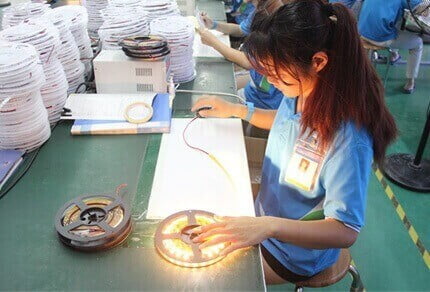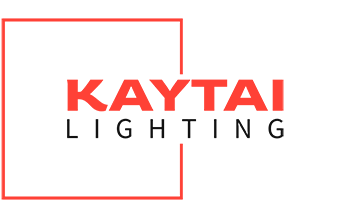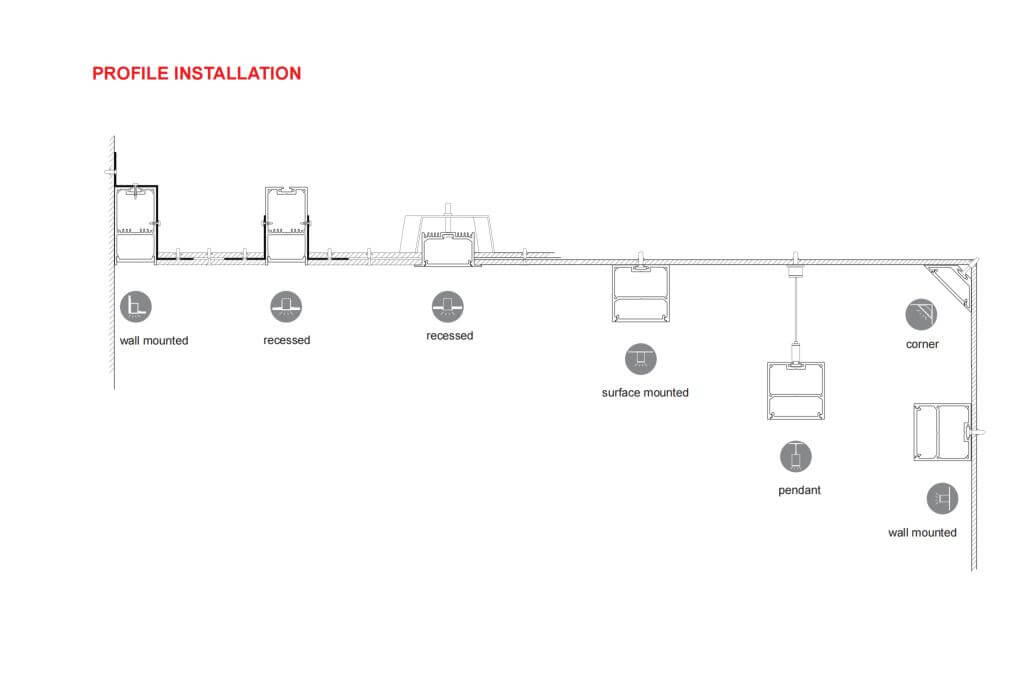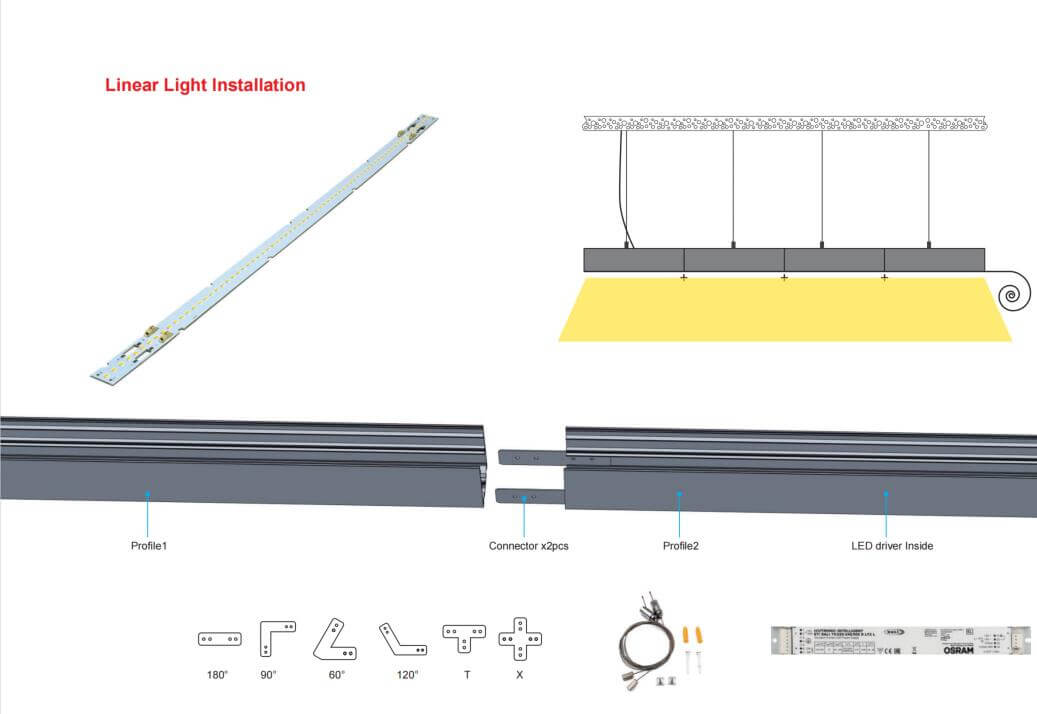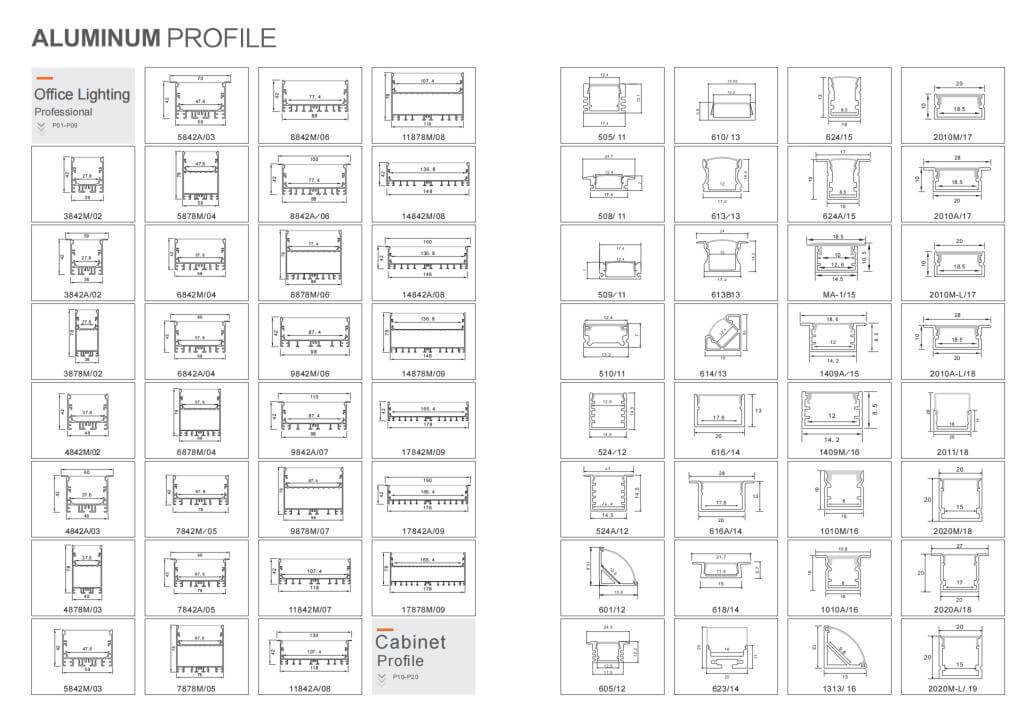Comment installer des profilés en aluminium LED pour des luminaires linéaires ?
LED aluminum profiles are essential components for installing LED strip lights. They help to protect your LED strips, improve heat dissipation, and enhance the overall aesthetic of your lighting setup. If you’re looking to install LED aluminum profiles in your home or office, follow this simple step-by-step guide. As a professional LED aluminum profile manufacturer from China, we’ll also share helpful tips and provide insight into choosing the right profiles for your LED strip lights.
Learn how to install LED aluminum profiles for linear lighting step by step. Discover how to protect your LED strips, improve heat dissipation, and create an elegant lighting effect with these easy-to-follow instructions from a leading China LED aluminum profile supplier.
Installing LED aluminum profiles is not only about improving the performance of your LED strip lights, but it also adds a sleek and modern touch to your lighting design. Whether you're lighting up a kitchen, office, or outdoor space, these profiles can be used for various applications. Let’s break down the installation process to make it simple for you.
Que sont les profilés en aluminium LED ?
LED aluminum profiles are specially designed channels that house LED strip lights. These profiles are made from high-quality aluminum, which helps with heat dissipation, extending the lifespan of your LED strips. They are available in different sizes, shapes, and finishes to fit various lighting needs and interior designs. LED aluminum profiles, also known as LED aluminum extrusions or channels, are essential for creating professional-looking LED installations.
What Tools Do You Need to Install LED Aluminum Profiles?
To properly install LED aluminum profiles, you will need the following tools:
- Screwdriver (for securing the profiles)
- Measuring Tape (for precise measurements)
- Miter Saw (for cutting profiles to the desired length)
- Drill (for making mounting holes)
- Adhesive or Screws (depending on the mounting method)
- LED Strips (make sure they fit into the profile)
These tools will help you complete the installation process quickly and accurately.
How to Install LED Aluminum Profiles Step by Step?
Follow these simple steps to install your LED aluminum profiles:
- Measure and Plan the Installation Area: Start by measuring the area where you want to install the LED aluminum profiles. Mark the points where the profiles will be placed, ensuring they are evenly spaced and aligned.
- Cut the Profiles to the Desired Length: Use a miter saw or hacksaw to cut the LED aluminum profiles to the required length. Be sure to wear safety glasses and gloves while cutting.
- Attach the Mounting Clips or Brackets: Depending on your profile design, you may need to use mounting clips or brackets to hold the profiles in place. Attach these to the wall or ceiling where the profiles will be installed.
- Insert the LED Strip Lights: Once the profile is securely mounted, carefully insert the LED strip lights into the aluminum channel. Make sure the LED strips are properly aligned and fit snugly within the profile.
- Connect the LED Strips to Power: Use the appropriate connectors or solder the wires to connect your LED strips to the power source. Ensure the voltage and power requirements are matched to avoid damage.
- Secure the Profile and Finish the Installation: Finally, secure the LED aluminum profiles to the mounting clips or brackets. If using adhesive, ensure it is properly bonded and holds the profile in place.
※ Claim 1: Ensure your LED aluminum profiles are compatible with the LED strips you're using to achieve optimal light output and cooling performance.
※ Claim 2: Make sure to check for any heat management issues when installing LED aluminum profiles in closed spaces to maintain the longevity of your LEDs.
What Are the Benefits of Using LED Aluminum Profiles?
LED aluminum profiles provide several advantages:
- Enhanced Heat Dissipation: The aluminum helps dissipate heat, preventing overheating and extending the lifespan of your LED strips.
- Improved Aesthetics: These profiles give your lighting setup a professional and sleek look, blending seamlessly with the interior design.
- Durability: LED aluminum channels are sturdy and protect your LED strips from physical damage and dust.
- Better Light Distribution: The profiles allow for uniform light diffusion, avoiding the “dots” effect often seen with bare LED strips.
How to Choose the Right LED Aluminum Profiles?
Choosing the right LED aluminum profile depends on several factors:
- Size and Shape: Consider the available space and the type of lighting effect you want to achieve.
- Mounting Type: Profiles can be surface-mounted, recessed, or suspended. Choose the one that suits your installation method.
- Finish: Opt for profiles with finishes that match the design of your room, such as anodized aluminum, matte black, or white.
※ Claim 1: As a leading China LED aluminum profile supplier, we offer a wide range of profiles to suit various installation needs and lighting effects.
※ Claim 2: You can find detailed information about our products and services on our website: Lightstec LED Aluminum Profiles.
Conclusion
Installing LED aluminum profiles is an excellent way to enhance the performance and appearance of your LED strip lights. By following these simple steps, you can achieve professional-looking lighting installations with ease. Whether you’re using LED strips for home decor or commercial spaces, these profiles will improve the longevity and efficiency of your lighting.
Q&A
1. Can I use any LED strip with aluminum profiles? Yes, as long as the LED strip fits into the profile, you can use any LED strip. Make sure the voltage and power ratings match.
2. How do I choose the right LED aluminum profile for my project? Consider the size, shape, and finish of the profiles to match your design needs. Also, choose profiles that fit your LED strips properly.
3. Do LED aluminum profiles improve light performance? Yes, they enhance heat dissipation, which helps maintain the performance and lifespan of your LED strips.
4. Can I install LED aluminum profiles outdoors? Yes, but ensure the profiles are designed for outdoor use and are properly sealed to prevent damage from weather.
5. How can I install LED aluminum profiles without drilling holes? You can use adhesive backing for a no-drill installation, though it may not be as sturdy as screws or clips.
Les gens se soucient également de ces questions :
- How to choose the right LED aluminum profiles for your project?
- What are the benefits of using LED aluminum extrusions?
- How to properly install LED strip lights in aluminum channels?
- What are the most common mistakes when installing LED aluminum profiles?
- What is the difference between LED aluminum channels and profiles?
Processus de fabrication des bandes lumineuses à LED
La production d'éclairage à LED nécessite une grande précision, mais de nombreux fabricants fabriquent leurs luminaires sur des chaînes de montage de base. Nous réglementons et surveillons strictement toutes les étapes de traitement dans notre système de fabrication. Nous disposons également d'un ensemble complet d'équipements destinés à la production et au contrôle de la qualité. Nous employons des ingénieurs expérimentés qui sont également des superviseurs d'usine pour assurer un contrôle de qualité strict pour chaque bande lumineuse à LED.
Nous espérons que cet article augmentera votre compréhension de l'industrie de l'éclairage LED et vous permettra de développer et d'explorer davantage la gamme de produits.

Étape 1. Matériau de la bande lumineuse à LED IQC
Les matériaux sont arrivés à l'usine, peu importe le PCB, la led, l'ic, la résistance, le profil en aluminium, les câbles, nécessitent un contrôle qualité. tous les articles doivent répondre à l'exigence. Le contrôle de la qualité est la première chose que nous devons faire lorsque tous les matériaux arrivent. Nous devons les inspecter, qu'ils soient qualifiés ou non --- cependant, il peut encore y avoir des produits défectueux qui ont traversé tout le processus de production --- des défauts de matériaux, de traitement ou d'expédition.

Étape 2. Vérification de la température de couleur des LED
Maintenant, avec toutes les nouvelles puces LED, vous devez tester la température de couleur des LED. La luminosité d'une même couleur n'est pas toujours la même. L'indice de rendu des couleurs est également un sujet dont vous devez vous assurer que le client.
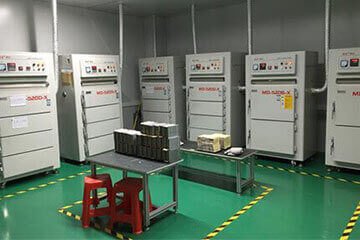
Étape 3. Processus à sec LED
Habituellement, ce processus sera suivi du processus SMT. La LED doit être séchée avant de traiter le SMT. La température du séchage n'est pas inférieure à 65℃ en 8 heures.
Étape 4. Processus SMT de bande lumineuse à LED
Le processus SMT de bande lumineuse à LED est largement utilisé dans les unités d'éclairage modernes. Ce qui est drôle, c'est que SMT signifie Surface Mount Technology, mais la technologie sur la façon de produire la LED n'est pas seulement appelée surface de montage, mais comprend également une machine automatisée à grande vitesse. Beaucoup de gens comprennent mal cela.

Étape 5. Processus de soudage par refusion de la bande LED
Processus de technologie de soudage par refusion après SMT, les composants et le PCB utilisant la pâte à souder. Le PCB de la machine à souder par refusion à une certaine température. La pâte à souder dans la consistance liquide de fondu, puis liée à différents composants.

Étape 6. Processus d'inspection des bandes lumineuses LED
nous avons un test à 100% pour nous assurer qu'il n'y a aucun dommage physique aux produits. L'inspection visuelle garantit qu'il n'y a pas de changement de couleur dans les LED et si des composants sont mal alignés dans les ponts de soudure.
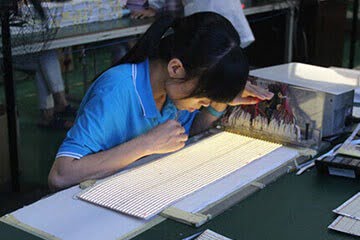
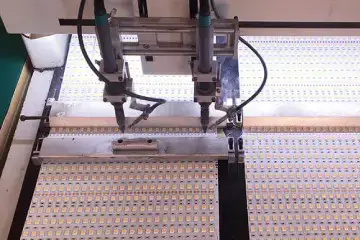
Étape 7. Processus de soudure de la bande lumineuse LED
Certains PCB de petite taille avec l'angle zéro, processus de soudure sans plomb. Après inspection, le ruban LED passe à travers une machine à souder, qui connecte un ruban de 0,5 m à des bandes de 5 m de long.

Étape 8. Processus de nettoyage de la carte PCB de la bande lumineuse à LED
La surface du PCB pour la bande LED a un fer à souder à nettoyer. La première chose à faire est encore de souder. Souder le CI peut être utilisé pour empêcher l'oxydation pendant le processus de soudure, puis couper l'excès de fil conducteur dans un tambour de dentifrice rond, comme l'oxydation. Une fois tout cela terminé, nous pouvons continuer à le nettoyer.
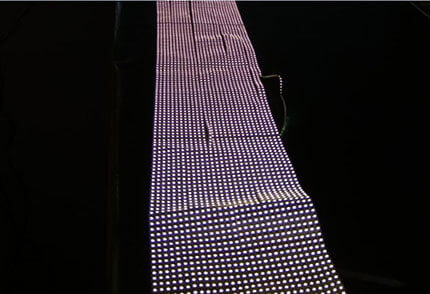
Étape 9. Processus de vieillissement de la bande LED
En fait, tous les produits à LED nécessitent un test d'éclairage pendant 8 heures, pour s'assurer que chaque LED fonctionne en bon état. Et nous pouvons mesurer les couleurs pendant le test d'éclairage, et si les LED sont à la bonne température de couleur, et si le pilote fonctionne bien. Il est donc très important pour le fabricant de s'assurer que toutes les LED fonctionnent correctement.
Étape 10. Processus imperméable à l'eau de la bande lumineuse à LED
Les bandes lumineuses à LED sont étanches et également résistantes à la rouille, ce qui les rend adaptées à un certain nombre d'applications à l'intérieur et à l'extérieur de la maison. La sélection du processus d'imperméabilisation des bandes lumineuses LED est une étape importante dans le processus de fabrication. Il existe sur le marché des tubes en silicone étanches IP65 de haute qualité et des injections de silicium IP67 étanches.
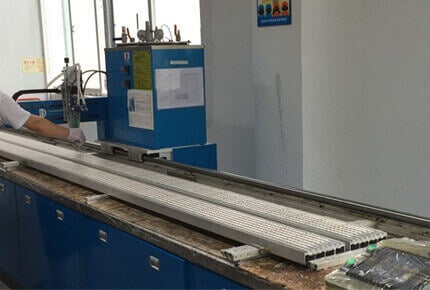
Étape 11. La bande lumineuse LED ajoute le processus de bande 3M
Le ruban 3M à l'arrière de la bande offre aux consommateurs la commodité et la facilité d'installation de l'éclairage à bande LED.
Nous utilisons 3M 9080 pour toutes les bandes non étanches et imperméables, certains clients demandent un autre adhésif 3M avec une meilleure adhérence ou une meilleure conductivité thermique, qui est également disponible.
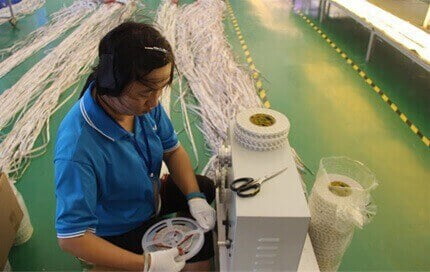
Étape 12. Inspection finale de la bande lumineuse LED
After the entire LED strip package has passed through our processing, LED Starlight's quality control department will perform a final check on our products. We not only make sure they have the same lighting color and are free from defects but also the appearance is good enough to meet the customers' requirements.
